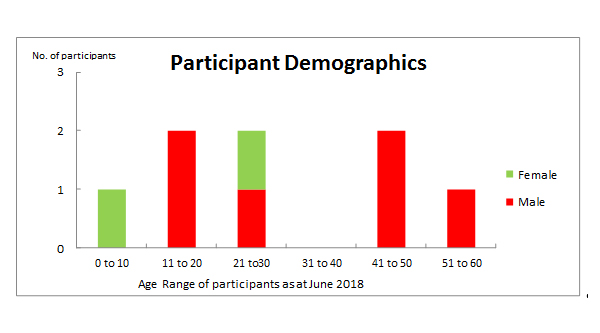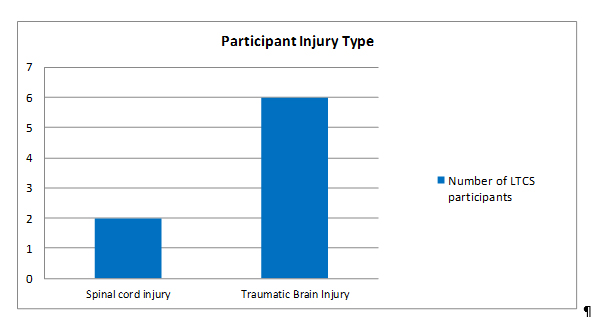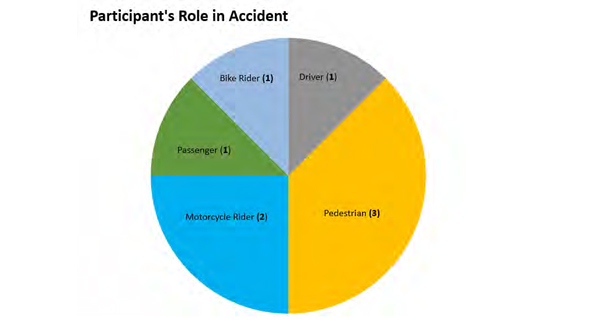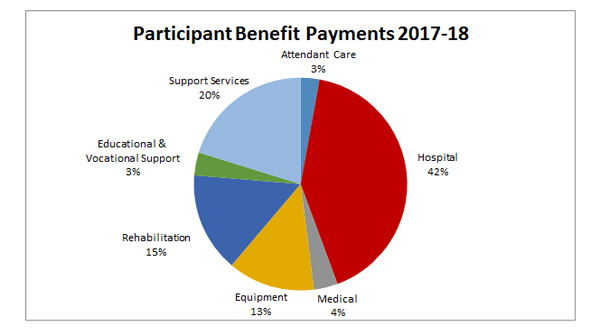Lifetime Care and Support Fund
Transmittal Certificate
Performance Reporting
The Lifetime Care and Support Scheme (LTCSS) is established under the Lifetime Care and Support (Catastrophic Injuries) Act 2014 (LTCS Act) and provides reasonable and necessary on-going treatment and care to people who have been catastrophically injured as a result of a motor accident or private sector work accident in the Australian Capital Territory. The types of injuries covered by the Scheme are spinal cord injuries, traumatic brain injury, amputations, severe burns and permanent blindness (more information can be found at http://apps.treasury.act.gov.au/ltcss).
The Scheme covers pedestrians, cyclists, motor bikes and motor vehicles so long as there is at least one registrable vehicle involved in a motor accident that occurs on or after 1 July 2014, regardless of where fault is attributable for the accident. As a result, it extends motor vehicle accident coverage for catastrophic injuries beyond what was previously available under Compulsory-third Party (CTP) Insurance to include those persons who may be considered to be at-fault, or someone who is involved in a single vehicle accident, or even a blameless accident.
The Scheme applies to catastrophic private sector work injuries that occur from 1 July 2016. An injured worker who is a lifetime participant of the LTCS Scheme no longer claims under the Workers Compensation Act 1951 for lifetime treatment and care needs covered by the LTCSS.
As it is a no-fault scheme, the LTCSS reduces the stress on those injured and their families that has previously been associated with litigating claims to meet ongoing treatment costs. It ensures early access to medical and rehabilitation care. Further, as treatment and care is on-going, those injured no longer have to worry whether a lump sum payment will meet their needs for the rest of their life and whether they will receive the ongoing treatment and care they require.
Examples of treatment and care provided to participants in the Scheme include:
- medical treatment;
- rehabilitation;
- attendant care services; and
- home and transport modification.
For motor accident injuries, the LTCSS is funded by a levy on CTP insurance policies. Private sector work injuries are fully funded through a separate levy collected from workers compensation insurers and self-insurers. The financial operations of the LTCSS are reflected in the LTCS Fund which is a separate financial reporting entity.
The LTCS Act is administered by the Chief Minister, Treasury and Economic Development Directorate (CMTEDD). Under section 10 of the LTCS Act, the Minister must appoint a public servant as the LTCS Commissioner of the Australian Capital Territory (ACT). The Executive Director of the Economic and Financial Group, CMTEDD was appointed by the Minister as the LTCS Commissioner commencing 13 May 2016.
The functions of the LTCS Commissioner are supported by the Financial Framework Management and Insurance Branch of the Economic and Financial Group, within CMTEDD.
The NSW government provides support for the ACT Scheme. The formal transfer of administration of the ACT Scheme to the NSW LTCS Authority occurred with effect from 1 September 2015. This fully gives effect to the IGA signed by the ACT Government in February 2015 with NSW, which enabled the LTCSA to provide co-ordinated lifetime care and support services on behalf of the LTCS Commissioner to participants in the ACT Scheme.
B.1.1 LTCS Commissioner Responsibilities
Under the provisions of the LTCS Act, some of the key responsibilities of the LTCS Commissioner are to:
- determine the LTCS levy amount;
- issue and monitor guidelines for the LTCSS;
- assess applications for eligibility for Scheme participation;
- assess reasonable and necessary treatment and care needs of participants; and
- pay assessed treatment and care needs.
B.1.2 Highlights
The key priorities for the LTCS Commissioner during the 2017-18 financial year were to:
- administer the LTCSS in accordance with the requirements of the LTCS Act and Guidelines;
- monitor how the Scheme is operating, including whether it is meeting participant expectations;
- continue to improve guidelines and procedures for the efficient and effective delivery of the LTCSS in consultation with our administration partners – the NSW Lifetime Care and Support Authority (NSW LTCSA);
- develop a memorandum of understanding with the National Disability Insurance Agency (NDIA) for the exchange of information about LTCS treatment and care expenses of LTCS scheme participants; and
- undertake investments in accordance with the Fund’s investment strategy.
Against these priorities, the LTCS Commissioner:
- determined, having regard to independent actuarial advice, the LTCS levy for motor vehicles and the LTCS levy for work injuries in 2018-19;
- commissioned and received the third LTCS participant feedback report on the administration and effectiveness of the Scheme services provided to participants, including recommendations on ways service delivery may be enhanced;
- provided input into the review of LTCS guidelines undertaken by the ACT’s administration partner, the NSW LTCSA, given the ACT’s guidelines largely mirror the guidelines of the NSW LTCS Scheme;
- liaised with the National Disability Insurance Authority on a Memorandum of Understanding for the sharing of information between the LTCS Commissioner and the NDIA; and
- invested an additional $15 million of funds not required in the short-term in accordance with the approved LTCSS investment strategy. The investment portfolio achieved an investment return for the 2017-18 financial year of 6.33%.
B.1.3 Our Participants
Applications to the Scheme
The LTCS Commissioner accepted one motor accident injury applicant as an interim participant in the Scheme during 2017-18. Another applicant was accepted as an interim participant on 8 August 2018 following determination by an independent review panel. The Commissioner had declined the motor accident injury application in 2017-18 on the grounds that it did not meet the eligibility criteria for entry into the Scheme. The claimant disputed the Commissioner’s decision, and in accordance with Part 7 of the LTCS Act, the Commissioner referred the dispute for assessment by an independent review panel.
The LTCS Commissioner received one new work injury application in the 2017-18 financial year for participation in the Scheme – the first work injury claim since the LTCS Scheme was extended to cover work injuries with effect from 1 July 2016. The applicant was accepted as an interim participant in the Scheme.
As at 30 June 2018, there are no outstanding applications to the Scheme for assessment.
Applying to the Scheme
“All participants commence as ‘interim participants’ for up to two years. During this time, the Scheme will pay for any reasonable and necessary treatment, rehabilitation and care related to the motor accident or work injury. After two years, an interim participant may be eligible to become a ‘lifetime participant’. Children do not apply for lifetime eligibility until they are at least five years old.”
Decisions about whether an interim participant is accepted as a lifetime participant are made before the end of the interim participation period. Around six months prior to the end of the interim participation period, a participant’s eligibility to remain in the Scheme is assessed to determine whether the person may have sufficiently recovered to the extent that they no longer meet the eligibility criteria after the two year period. If it is assessed that the injured person is likely to meet the eligibility criteria beyond two years, the person is accepted into the Scheme for life. During 2017-18, no interim participants were assessed for lifetime participation in the LTCS Scheme.
Participant profile
As at 30 June 2018 there are eight participants who are receiving co-ordinated treatment and care benefits through the Scheme. Of the eight participants in the Scheme, four are lifetime participants and four are interim participants.
The LTCSS continues to have quite a young age demographic with the average age of participants currently 27 years of age. Of the eight participants in the Scheme as at 30 June 2018, only one participant is under ten years of age.

The Scheme covers five types of catastrophic injuries – traumatic brain injury, spinal cord injury, amputations, burns and vision loss. Six participants (75 %) have suffered a traumatic brain injury.

In terms of how Scheme participants were injured, the participant under ten years of age was a passenger in a motor vehicle accident that caused her injuries. Three of the participants were injured as pedestrians in accidents involving a motor vehicle and one participant was injured while riding a bicycle. For the three drivers injured in motor vehicle accidents, two were motorcycle riders.

Participants’ perception of the LTCS Scheme support for recovery and rehabilitation goals
Feedback from participants and their nominated persons in a Participant Feedback Research conducted in May 20188 continues to be very positive about the existence of the scheme. Some of the comments from participants and their nominated persons of the Scheme include:
“I can see the business case for the Scheme, but that is implemented in a way that is treating people like human beings … that is really impressive.”
“It is an exceptional Scheme and I can’t begin to think what it would have been like if it didn’t exist. Its so catstrophic it is not worth thinking about.”
All interviewed participants and/or their nominated persons reflected that the Scheme substantially meets participant needs at their individual stage of recovery and rehabilitation and assists them in meeting their goals.
“The level of support that the whole Scheme offers. They can really help you”.
“A huge strength of the Scheme is that it is not a cookie-cutter Scheme, they really do look at the needs of this person, and it was so collaborative….”
“I know I’ve set out some suggestions … but I hope you understand that we think the Scheme is exceptional. It shows the strength of the team and the strength of the Scheme that it is so flexible and responsive to the needs of the person.”
Provided Treatment, Rehabilitation and Care
In 2017-18, the LTCS Commissioner spent a total of $772,105 on services for participants. As expected, given there were two new participants accepted in the year, hospital expenses accounted for the largest expenditure category (42%) of participant expenses.
The second highest expense category related to support services (20%), which comprises mainly case management fees and travel expenses for participants and service providers to access/provide medical review and treatment. Rehabilitation (15%) and equipment (13%) were the next largest expense categories.

In comparison, in 2016-17, the LTCS Commissioner spent a total of $472,447 on services for participants. The largest expenditure categories in 2016-17 were for rehabilitation (25%) and support services (23%), reflecting the recovery and rehabilitation needs of those participants who had been in the Scheme for two or more years.
Accessing Services – How the scheme works with participants
“The LTCS Scheme provides reasonable and necessary treatment, rehabilitation and care as it is required throughout the person’s life and assists them to plan their rehabilitation and care services.
Participants are supported as needed by a LTCSS coordinator. The coordinator arranges for a case manager to help plan services required by the participant.
The case manager will work with the participant and their service providers to request approval for services. Services are organised as required and the participant and their families are closely involved in each of these requests. Usually payment of approved treatment and care needs is made by the LTCSS directly to the supplier of the services.”
In the participant research undertaken in May 2018, participants were asked about their experiences accessing and using services and equipment, and if there had been any issues with these. Overall, participants were very positive about both the services and equipment funded by LTCS.
“ I would have missed out on surgeries and physiotherapy if it didn’t exist. I would be a lot worse off.”
B.1.4 Outlook
Strategic priorities in 2018-19 for the LTCS Commissioner include:
- administer the LTCSS in accordance with the requirements of the LTCS Act and Guidelines;
- collect annual feedback from participants on their expectations and experience with the LTCSS and in consultation with our administration partner, the NSW LTCSA, implement improvements to the way LTCS scheme benefits are delivered to ACT participants;
- implement changes to improve the ACT LTCS Guidelines following on from the review of LTCS Guidelines by NSW LTCSA;
- finalise the development of a memorandum of understanding with the National Disability Insurance Agency for the exchange of information about LTCS treatment and care expenses of LTCS Scheme participants; and
- undertake investments in accordance with the Fund’s investment strategy.
B.2 Performance analysis
The LTCSS’ 2017-18 performance indicators are included in the Budget Portfolio Statements for the LTCS Fund, and are reported as part of the LTCS Fund’s Statement of Performance.
The LTCS Fund achieved all its accountability targets in 2017-18, with the exception of its investment earning rate.
Explanation of Performance Indicators
a. Independent actuarial review to advise on the required fund contribution
The LTCS levies are crucial to the funding of the Scheme, with a levy applying to all CTP policies payable at the time of vehicle registration and a levy applied to private sector workers’ compensation insurers. As required by the LTCS Act, the levies are set by the LTCS Commissioner based on independent actuarial advice. The level at which the levies are set in any given year is intended to secure sufficient funds to meet the costs of all estimated present and future liabilities of new participants of the LTCSS in that year. The LTCS levies are for a financial year and are set in May/June before the commencement of a financial year on 1 July.
In accordance with section 83 of the LTCS Act, the LTCS Commissioner obtained before the beginning of the contribution period, a report from an independent actuary in relation to the amounts needed to be contributed to the LTCS fund for the contribution period.
Two actuarial reports for the 2018-19 contribution period were undertaken by Finity for the purposes of setting the 2018-19 LTCS Levy for motor vehicle injuries and the LTCS levy for work injuries. The final actuarial reports were received in March 2018.
b. Determine LTCS Levies
The LTCS Commissioner determined that the LTCS levy for a twelve-month CTP policy would be increased to $36.50 in 2018-19 (previously $35.00 in 2017-18) for all vehicles except those that are subject to distance restrictions applicable as part of the ACT’s Concessional Vintage Vehicle Registration (CVVR) Scheme. As a result of the increase to the LTCS levy for general passenger vehicles, the LTCS Levy determined for the CVVR Scheme has increased to $7.30 in 2018-19 (from $7.00 in 2017‑18) for a twelve‑month CTP policy.
The Levy determination for the 2018-19 contribution period for both motor vehicles and private sector workers compensation insurers and self-insurers, was notified on the Legislation Register on 11 May 2018.
The LTCS Commissioner has determined these LTCS levies based on the best available data. As the Scheme will only be in its fifth year of operation for motor vehicle accidents and in its third year of operation for work accidents, a high degree of uncertainty still remains with respect to the number of participants and the costs of providing services. By the very nature of the injury type covered by the Scheme, the experience can be expected to be volatile from year to year. Noting that it will take many years of experience before more robust scheme data becomes available, the LTCS Commissioner will continue to reassess the levy amounts yearly, on the basis of updated advice provided by an independent actuary.
c. Undertake an annual participant feedback process
A survey of the LTCSS participants was conducted by Modd Research and Evaluation Pty Ltd in
May 2018 with a final report received in June 2018. The survey was conducted by a social research consultant who specialises in undertaking research of services in the disability and health sectors.
The purpose of the survey was to seek feedback from selected LTCSS participants and their nominated representatives to understand their perceptions and experience with the LTCSS and whether the Scheme continues to support them at the particular stage in their recovery and rehabilitation. Analysis based on the feedback was used to identify opportunities for improvements in the operation of the LTCSS and to ensure that the Scheme’s focus remains on rehabilitation and recovery outcomes. All LTCSS participants invited to participate agreed to be interviewed as part of the survey.
Overall the research reported that respondents gave very positive feedback on the extent and manner in which the Scheme supports the rehabilitation and ongoing well-being of participants. The Scheme continues to meet participants’ needs at their individual stage of recovery and rehabilitation and to assist them in meeting those goals. All participants and their families interviewed reported that they felt well-supported by their case manager and the Scheme’s coordinator care team.
Within this positive context, participants also suggested improvements. These point to opportunities for refining operational processes around the inclusion of information or other means of engagement to:
- promote more open lines of communication between the case manager and LTCS care team or between the care team and the participant; and
- support greater participant independence, choice and control in their treatment and care where appropriate.
As the results of the research relate to the administrative processes of the LTCSA (the ACT’s partner in administering LTCSS benefits to ACT participants), a copy of the research report and findings has been provided to the LTCSA and the findings have been discussed with them.
d Difference between the investment earning rate and the benchmark is = 0
In 2017-18, the LTCS investment return has been less than the benchmark due to the current small size of the fund’s total investment relative to the size of each investment. This means there is currently a material impact on the fund’s annual returns from the transaction costs payable each time funds are invested. This is likely to persist for some years until the fund reaches a certain size and maturity relative to the size of the new investments being made in a given year. The same indicator has been retained in 2018-19 as the LTCSS invests in a passive fund (it largely matches the companies included in the market indices) and it is hence unlikely to exceed the benchmark return performance.
B.3 Scrutiny
During the reporting period the LTCSS did not participate in any Legislative Assembly Committee inquiries related to its activities. There were no Ombudsman Reports.
However, the Auditor-General Report No.1 of 2018: ACT Government Strategic and Accountability Indicators made a number of recommendations that were relevant for the Lifetime Care and Support Fund. In regard to:
- Recommendation 2 (a), the Lifetime Care and Support Fund has been requested to amend accountability indicators to explain how they support achievement of government priorities; and
- Recommendation 4, all Territory entities, including the Lifetime Care and Support Fund, have been requested to document their procedure for the review, selection and approval of strategic and accountability indicators.
The amendment of accountability indicators [recommendation 2 (a)] and the documentation of procedures for the review, selection and approval of strategic and accountability indicators (recommendation 4) will be reviewed in line with updated guidance material once it has been released.
B.4 Risk Management
The LTCSS is part of CMTEDD. As such, it is covered in CMTEDD’s risk management arrangements.
B.5 Internal Audit
The LTCSS is part of the CMTEDD Audit and Risk Committee. CMTEDD’s Annual Report section on the Internal Audit Committee applies to the LTCSS.
No internal audits of the LTCSS were undertaken during 2017-18.
B.6 Fraud Prevention
The LTCSS is part of CMTEDD. As such, it is covered in CMTEDD’s Fraud and Corruption Prevention Plan.
B.7 Workplace Health and Safety
The LTCSS is part of CMTEDD. CMTEDD’s Annual Report section on Workplace Health and Safety practices applies to the LTCSS.
B.8 Human Resource Management
The LTCSS is part of CMTEDD. CMTEDD’s Annual Report section on HR management applies to the LTCSS.
B.9 Ecologically Sustainable Development
The CMTEDD’s Annual Report section on Ecologically Sustainable Development applies to the LTCSS.
C.3 Capital Works
The LTCS Commissioner did not undertake any Capital Works Projects in the 2017-18 financial year.
C.4 Asset Management
The LTCS Commissioner has no intangible assets.
C.5 Government Contracting
The LTCS Commissioner did not have any contracts which value exceeds $25,000 signed in 2017-18.
Further Information can be obtained from
Sue Vroombout
Lifetime Care and Support Commissioner
Economic and Financial Group
+ 61 2 6205 3216
Sue.Vroombout@act.gov.au
